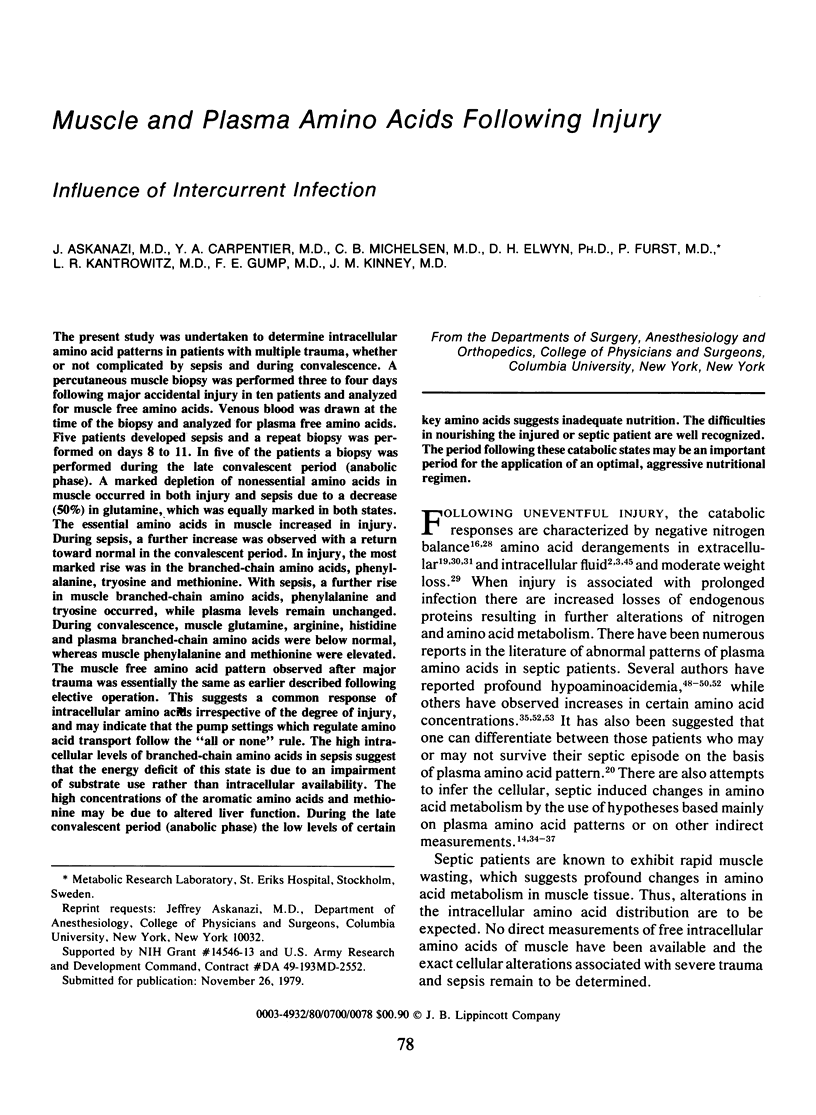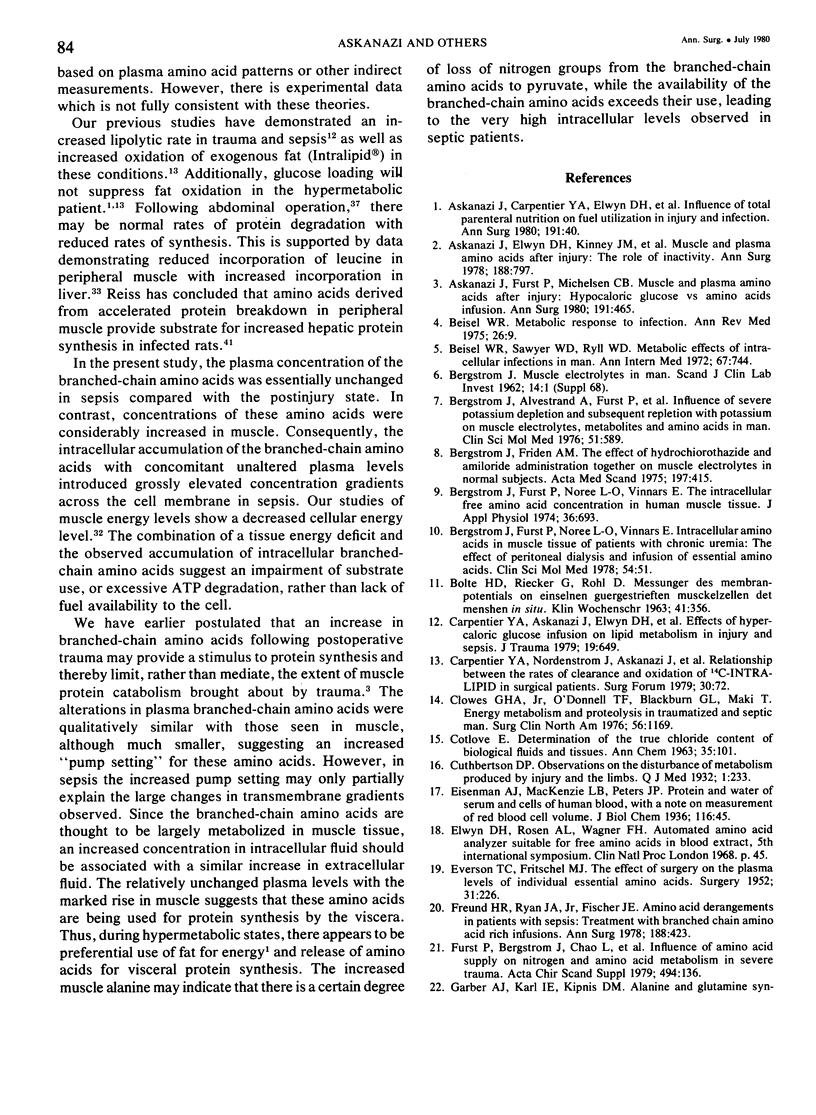Abstract
The present study was undertaken to determine intracellular amino acid patterns in patients with multiple trauma, whether or not complicated by sepsis and during convalescence. A percutaneous muscle biopsy was performed three to four days following major accidental injury in ten patients and analyzed for muscle free amino acids. Venous blood was drawn at the time of the biopsy and analyzed for plasma free amino acids. Five patients developed sepsis and a repeat biopsy was performed on days 8 to 11. In five of the patients a biopsy was performed during the late convalescent period (anabolic phase). A marked depletion of nonessential amino acids in muscle occurred in both injury and sepsis due to a decrease (50%) in glutamine, which was equally marked in both states. The essential amino acids in muscle increased in injury. During sepsis, a further increase was observed with a return toward normal in the convalescent period. In injury, the most marked rise was in the branched-chain amino acids, phenylalanine, tryosine and methionine. With sepsis, a further rise in muscle branched-chain amino acids, phenylalanine and tryosine occurred, while plasma levels remain unchanged. During convalescence, muscle glutamine, arginine, histidine and plasma branched-chain amino acids were below normal, whereas muscle phenylalanine and methionine were elevated. The muscle free amino acid pattern observed after major trauma was essentially the same as earlier described following elective operation. This suggests a common response of intracellular amino acids irrespective of the degree of injury, and may indicate that the pump settings which regulate amino acid transport follow the “all or none” rule. The high intracellular levels of branched-chain amino acids in sepsis suggest that the energy deficit of this state is due to an impairment of substrate use rather than intracellular availability. The high concentrations of the aromatic amino acids and methionine may be due to altered liver function. During the late convalescent period (anabolic phase) the low levels of certain key amino acids suggests inadequate nutrition. The difficulties in nourishing the injured or septic patient are well recognized. The period following these catabolic states may be an important period for the application of an optimal, aggressive nutritional regimen.
Full text
PDF







Selected References
These references are in PubMed. This may not be the complete list of references from this article.
- Askanazi J., Carpentier Y. A., Elwyn D. H., Nordenström J., Jeevanandam M., Rosenbaum S. H., Gump F. E., Kinney J. M. Influence of total parenteral nutrition on fuel utilization in injury and sepsis. Ann Surg. 1980 Jan;191(1):40–46. doi: 10.1097/00000658-198001000-00008. [DOI] [PMC free article] [PubMed] [Google Scholar]
- Askanazi J., Elwyn D. H., Kinney J. M., Gump F. E., Michelsen C. B., Stinchfield F. E., Fürst P., Vinnars E., Bergström J. Muscle and plasma amino acids after injury: the role of inactivity. Ann Surg. 1978 Dec;188(6):797–803. doi: 10.1097/00000658-197812000-00014. [DOI] [PMC free article] [PubMed] [Google Scholar]
- Askanazi J., Furst P., Michelsen C. B., Elwyn D. H., Vinnars E., Gump F. E., Stinchfield F. E., Kinney J. M. Muscle and plasma amino acids after injury: hypocaloric glucose vs. amino acid infusion. Ann Surg. 1980 Apr;191(4):465–472. doi: 10.1097/00000658-198004000-00013. [DOI] [PMC free article] [PubMed] [Google Scholar]
- BOLTE H. D., RIECKER G., ROHL D. [Measurements of the membrane potential of single cross-striated muscles of man in situ. Normal values]. Klin Wochenschr. 1963 Apr 15;41:356–359. doi: 10.1007/BF01487862. [DOI] [PubMed] [Google Scholar]
- Beisel W. R. Metabolic response to infection. Annu Rev Med. 1975;26:9–20. doi: 10.1146/annurev.me.26.020175.000301. [DOI] [PubMed] [Google Scholar]
- Beisel W. R., Sawyer W. D., Ryll E. D., Crozier D. Metabolic effects of intracellular infections in man. Ann Intern Med. 1967 Oct;67(4):744–779. doi: 10.7326/0003-4819-67-4-744. [DOI] [PubMed] [Google Scholar]
- Bergström J., Alvestrand A., Fürst P., Hultman E., Sahlin K., Vinnars E., Widström A. Influence of severe potassium depletion and subsequent repletion with potassium on muscle electrolytes, metabolites and amino acids in man. Clin Sci Mol Med. 1976 Dec;51(6):589–599. doi: 10.1042/cs0510589. [DOI] [PubMed] [Google Scholar]
- Bergström J., Fürst P., Norée L. O., Vinnars E. Intracellular free amino acid concentration in human muscle tissue. J Appl Physiol. 1974 Jun;36(6):693–697. doi: 10.1152/jappl.1974.36.6.693. [DOI] [PubMed] [Google Scholar]
- Bergström J., Fürst P., Norée L. O., Vinnars E. Intracellular free amino acids in muscle tissue of patients with chronic uraemia: effect of peritoneal dialysis and infusion of essential amino acids. Clin Sci Mol Med. 1978 Jan;54(1):51–60. doi: 10.1042/cs0540051. [DOI] [PubMed] [Google Scholar]
- Bergström J. The effect of hydrochlorothiazide and amiloride administered together on muscle electrolytes in normal subjects. Acta Med Scand. 1975 May;197(5):415–419. doi: 10.1111/j.0954-6820.1975.tb04942.x. [DOI] [PubMed] [Google Scholar]
- Carpentier Y. A., Askanazi J., Elwyn D. H., Jeevanandam M., Gump F. E., Hyman A. I., Burr R., Kinney J. M. Effects of hypercaloric glucose infusion on lipid metabolism in injury and sepsis. J Trauma. 1979 Sep;19(9):649–654. doi: 10.1097/00005373-197909000-00002. [DOI] [PubMed] [Google Scholar]
- Carpentier Y. A., Nordenström J., Askanazi J., Elwyn D. H., Gump F. E., Kinney J. M. Relationship between rates of clearance and oxidation of 14C-intralipid in surgical patients. Surg Forum. 1979;30:72–74. [PubMed] [Google Scholar]
- Clowes G. H., Jr, O'Donnell T. F., Blackburn G. L., Maki T. N. Energy metabolism and proteolysis in traumatized and septic man. Surg Clin North Am. 1976 Oct;56(5):1169–1184. doi: 10.1016/s0039-6109(16)41036-4. [DOI] [PubMed] [Google Scholar]
- EVERSON T. C., FRITSCHEL M. J. The effect of surgery on the plasma levels of the individual essential amino acids. Surgery. 1952 Feb;31(2):226–232. [PubMed] [Google Scholar]
- Freund H. R., Ryan J. A., Jr, Fischer J. E. Amino acid derangements in patients with sepsis: treatment with branched chain amino acid rich infusions. Ann Surg. 1978 Sep;188(3):423–430. doi: 10.1097/00000658-197809000-00017. [DOI] [PMC free article] [PubMed] [Google Scholar]
- Garber A. J., Karl I. E., Kipnis D. M. Alanine and glutamine synthesis and release from skeletal muscle. I. Glycolysis and amino acid release. J Biol Chem. 1976 Feb 10;251(3):826–835. [PubMed] [Google Scholar]
- Graham J. A., Lamb J. F., Linton A. L. Measurement of body water and intracellular electrolytes by means of muscle biopsy. Lancet. 1967 Dec 2;2(7527):1172–1176. doi: 10.1016/s0140-6736(67)91892-2. [DOI] [PubMed] [Google Scholar]
- Hill G. L., Blackett R. L., Pickford I., Burkinshaw L., Young G. A., Warren J. V., Schorah C. J., Morgan D. B. Malnutrition in surgical patients. An unrecognised problem. Lancet. 1977 Mar 26;1(8013):689–692. doi: 10.1016/s0140-6736(77)92127-4. [DOI] [PubMed] [Google Scholar]
- Kedenburg C. P. A lithium buffer system for accelerated single-column amino acid analysis in physiological fluids. Anal Biochem. 1971 Mar;40(1):35–42. doi: 10.1016/0003-2697(71)90081-9. [DOI] [PubMed] [Google Scholar]
- Kinney J. M., Long C. L., Gump F. E., Duke J. H., Jr Tissue composition of weight loss in surgical patients. I. Elective operation. Ann Surg. 1968 Sep;168(3):459–474. doi: 10.1097/00000658-196809000-00013. [DOI] [PMC free article] [PubMed] [Google Scholar]
- LEVENSON S. M., HOWARD J. M., ROSEN H. Studies of the plasma amino acids and amino conjugates in patients with severe battle wounds. Surg Gynecol Obstet. 1955 Jul;101(1):35–47. [PubMed] [Google Scholar]
- LaBrosse E. H., Beech J. A., McLaughlin J. S., Mansberger A. R., Keene W. D., 3rd, Cowley R. A. Plasma amino acids in normal humans and patients with shock. Surg Gynecol Obstet. 1967 Sep;125(3):516–520. [PubMed] [Google Scholar]
- Marchuk J. B., Finley R. J., Groves A. C., Wolfe L. I., Holliday R. L., Duff J. H. Catabolic hormones and substrate patterns in septic patients. J Surg Res. 1977 Sep;23(3):177–182. doi: 10.1016/0022-4804(77)90018-x. [DOI] [PubMed] [Google Scholar]
- Miller J. D., Blackburn G. L., Bistrian B. R., Rienhoff H. Y., Trerice M. Effect of deep surgical sepsis on protein-sparing therapies and nitrogen balance. Am J Clin Nutr. 1977 Sep;30(9):1528–1532. doi: 10.1093/ajcn/30.9.1528. [DOI] [PubMed] [Google Scholar]
- O'Donnel T. F., Clowes G. H., Jr, Blackburn G. L., Ryan N. T., Benotti P. N., Miller J. D. Proteolysis associated with a deficit of peripheral energy fuel substrates in septic man. Surgery. 1976 Aug;80(2):192–200. [PubMed] [Google Scholar]
- O'Keefe S. J., Sender P. M., James W. P. "Catabolic" loss of body nitrogen in response to surgery. Lancet. 1974 Nov 2;2(7888):1035–1038. doi: 10.1016/s0140-6736(74)92149-7. [DOI] [PubMed] [Google Scholar]
- Odessey R., Goldberg A. L. Oxidation of leucine by rat skeletal muscle. Am J Physiol. 1972 Dec;223(6):1376–1383. doi: 10.1152/ajplegacy.1972.223.6.1376. [DOI] [PubMed] [Google Scholar]
- Odessey R., Khairallah E. A., Goldberg A. L. Origin and possible significance of alanine production by skeletal muscle. J Biol Chem. 1974 Dec 10;249(23):7623–7629. [PubMed] [Google Scholar]
- REISS E. Protein metabolism in infection. I. Changes in certain visceral proteins studied with glycine-N 15. Metabolism. 1959 Mar;8(2):151–159. [PubMed] [Google Scholar]
- Rapoport M. I., Beisel W. R. Studies of tryptophan metabolism in experimental animals and man during infectious illness. Am J Clin Nutr. 1971 Jul;24(7):807–814. doi: 10.1093/ajcn/24.7.807. [DOI] [PubMed] [Google Scholar]
- Royle G., Kettlewell M. G., Ilic V., Williamson D. H. Galactose and hepatic metabolism in malnutrition and sepsis in man. Clin Sci Mol Med. 1978 Aug;55(2):199–204. doi: 10.1042/cs0550199. [DOI] [PubMed] [Google Scholar]
- Ryan N. T., Blackburn G. L., Clowes H. A., Jr Differential tissue sensitivity to elevated endogenous insulin levels during experimental peritonitis in rats. Metabolism. 1974 Nov;23(11):1081–1089. doi: 10.1016/0026-0495(74)90075-4. [DOI] [PubMed] [Google Scholar]
- Saunders S. J., Truswell A. S., Barbezat G. O., Wittman W., Hansen J. D. Plasma free aminoacid pattern in protein-calorie malnutrition. Reappraisal of its diagnostic value. Lancet. 1967 Oct 14;2(7520):795–797. doi: 10.1016/s0140-6736(67)92233-7. [DOI] [PubMed] [Google Scholar]
- Vinnars E., Bergstöm J., Fürst P. Influence of the postoperative state on the intracellular free amino acids in human muscle tissue. Ann Surg. 1975 Dec;182(6):665–671. doi: 10.1097/00000658-197512000-00001. [DOI] [PMC free article] [PubMed] [Google Scholar]
- Walesby R. K., Goode A. W., Bentall H. H. Nutritional status of patients undergoing valve replacement by open heart surgery. Lancet. 1978 Jan 14;1(8055):76–77. doi: 10.1016/s0140-6736(78)90008-9. [DOI] [PubMed] [Google Scholar]
- Wannemacher R. W., Jr, Dinterman R. E., Pekarek R. S., Bartelloni P. J., Beisel W. R. Urinary amino acid excretion during experimentally induced sandfly fever in man. Am J Clin Nutr. 1975 Feb;28(2):110–118. doi: 10.1093/ajcn/28.2.110. [DOI] [PubMed] [Google Scholar]
- Wannemacher R. W., Jr Key role of various individual amino acids in host response to infection. Am J Clin Nutr. 1977 Aug;30(8):1269–1280. doi: 10.1093/ajcn/30.8.1269. [DOI] [PubMed] [Google Scholar]
- Wannemacher R. W., Jr Key role of various individual amino acids in host response to infection. Am J Clin Nutr. 1977 Aug;30(8):1269–1280. doi: 10.1093/ajcn/30.8.1269. [DOI] [PubMed] [Google Scholar]
- Wannemacher R. W., Jr, Klainer A. S., Dinterman R. E., Beisel W. R. The significance and mechanism of an increased serum phenylalanine-tyrosine ratio during infection. Am J Clin Nutr. 1976 Sep;29(9):997–1006. doi: 10.1093/ajcn/29.9.997. [DOI] [PubMed] [Google Scholar]
- Wannemacher R. W., Jr, Powanda M. C., Pekarek R. S., Beisel W. R. Tissue amino acid flux after exposure of rats to Diplococcus pneumoniae. Infect Immun. 1971 Nov;4(5):556–562. doi: 10.1128/iai.4.5.556-562.1971. [DOI] [PMC free article] [PubMed] [Google Scholar]
- Young V. R., Huang P. C. In vivo uptake of [14C]leucine by skeletal muscle ribosomes after injury in rats fed two levels of protein. Br J Nutr. 1969 Jun;23(2):271–280. doi: 10.1079/bjn19690034. [DOI] [PubMed] [Google Scholar]


